Flying into Miami on American Airlines flight 1908 from Port-au-Prince was terrifying. It wasn't the competence of the pilot that was of concern, but descending out of the darkness into the beautiful but blinding lights of the American urban landscape was more disorienting than severe turbulence. The mind -- still seared with the sights, sounds and smells of Haiti -- was waking to a different reality, but the last week had not been a dream. It was all too real. As my friend fetched me from the door at customs, he asked about what I had experienced on this trip. I said that I was afraid to start talking because I might not stop, and then directed the conversation to his family.
But, disjointed words flowed as we drove and later dominated the dinner conversation at his home. It was compulsive speech -- a disgorgement of emotion and anger. I apologized. His wife, who is a cultural anthropologist and also my friend, told me that when I write about my latest experiences, I should term my responses "empathy" and not "compassion" as I had in my past writing. There is truth in empathy, she said, and what I was experiencing was attunement to the emotions of the Haitian people. Just tell the stories. Put yourself back into that space and explain how their emotion transferred itself into your intellect.
The intellect stretches to describe and explain the harm and abuse that Haiti endures.
The January 2010 Haiti earthquake that killed up to 300,000 and left 1.5 million or more homeless served to rip the scab off a wound that international interests inflicted on this island nation over 200 years ago. Now, Haiti is bleeding more profusely, and those same international interests are scrambling to dress the wound, but not cure the infection that threatens to turn cancerous, if it has not already. Haiti is not bloody enough for the cameras today, so the major news organizations have dashed to Egypt, where there is great promise for fresh blood that will wash across the camera lenses and raise ratings, without exposing yet another infection caused by years of international meddling.
Dying is fascinating. The living are not as interesting. And it is the living who make up the connective tissue that holds Haitian society together. Unless they are allowed to heal, Haiti cannot heal. The displaced and dispossessed are invisible because we do not look closely, preferring to hold ourselves at a safe distance.
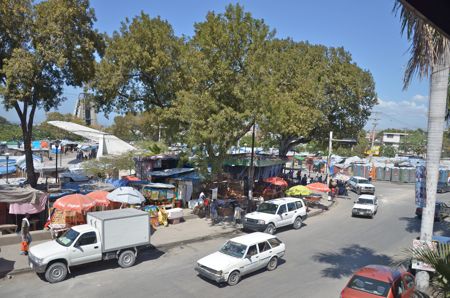
Stand on the balcony of the Plaza Hotel on the Champ de Mars and you will see what CNN shows you. The locals call it "Anderson Cooper's balcony." The gates of the hotel are guarded, buffering the guests from the Internally Displaced Persons (IDP) camp that is located less than 200 feet across the street. The camp is one of at least 1300 that appeared after the quake.
The people who now live there once had homes, businesses, and family members who were lost in the earthquake. These are individuals and not acronyms called "IDPs."
We crossed the street to find friends and acquaintances we made over the last year. Immediately inside the rabbit's warren of huts, tents and shacks, we encountered a man named Henry. We politely said hello, and then Henry wanted to show us where he lived with his wife and six children -- a small shack made of salvaged material, but proudly featuring a ceiling fan that was miraculously connected to an electrical source. Whether the contraption was battery or AC-powered was unclear, since the wires disappeared through the rusted tin roof, but it did provide a whisper of air movement in the sweltering interior.
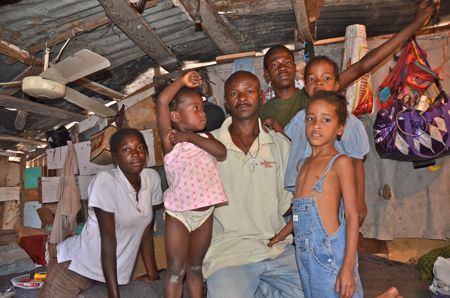
But, something else was more disturbing than the horrible conditions the family, which once had a home and small business, had to endure. The day before, on February 7, small demonstrations took place in Port-au-Prince. The reasons were not entirely clear, but generally the 300 or so demonstrators wanted the immediate removal of President Rene Preval. His term is up. But the election process has been delayed due to vote recounts, fraud, international pressure, and meddling.

Ballot boxes that should be under lock and key have been converted to breadboxes at roadside stands. Can you imagine the hue and cry if that happened during the 2000 US presidential race? The outcome of this electoral process will determine Haiti's immediate future and the fate of the homeless in the earthquake zone.
The November 28 elections were critically flawed by all accounts, but the members of the organization in charge of examining fraud, the expert verification mission of the Organization of American States (OAS), are from the United States, Canada, and France. Jamaica is the only Caribbean nation on the team. Mark Weisbrot of the independent think tank CEPR has an excellent analysis here.
That is the background behind the demonstrations, but you can see how the background is already distracting and distancing us from Henry's story.
The demonstrators acted out of hand and out of anger, but there is some speculation that they were paid to do so. I have no proof of this, but that is what people on the street were saying. Riot police were called as stones were lobbed and a few tires were set on fire outside of the camp. Police who could not shoot straight fired tear gas canisters, and the canisters landed in the camp, where the residents are sick and tired of it all and just want a new government. The people are apolitical -- at least the people we spoke with are. At this point any new government, any new president will do after a year of living in conditions not fit for animals.
One of the tear gas canisters landed near the area where three of Henry's children were playing. He ran to them, scooped two up in his arms while the smallest scrambled onto his back, and carried them away from the fumes.
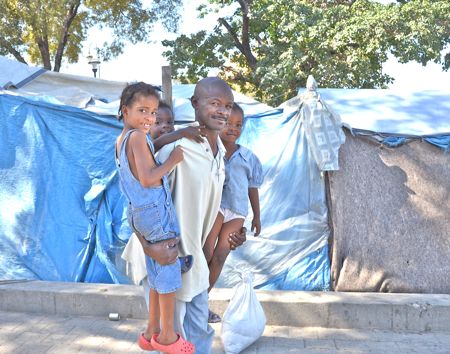
Henry was angry that his family was paying the price for the actions of a few. This has happened more than once. Thieves, pickpockets and rapists use the camp as an escape route. Disappearing within the passageways is as easy as hiding in a cornfield. The children are not safe and must be under the watchful eyes of family protectors at all times.
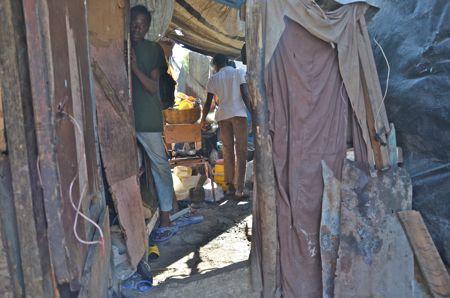
We met some of Henry's neighbors, including a woman who has been partially paralyzed since the quake, children with fevers, and babies with non-functioning limbs. Had any medical teams visited? The answer was no, but our translator directed the suffering to a clinic operated by an Israeli team that was nearby.
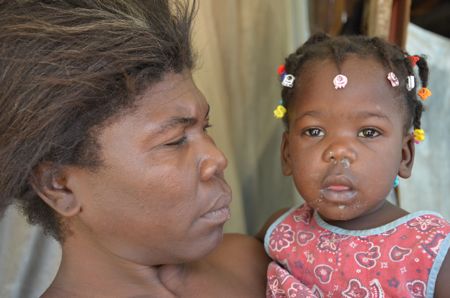
After an hour or more we said goodbye to Henry and moved on across the camp to visit an old friend, Venise, whom we had met in May 2010. The International Medical Corps (IMC) gave us a large tent for her so she could move her family back to their neighborhood, but they had a mountain of rubble to remove by hand before they could set up the tent. We learned that Venise was still in the camp and wanted to say hello.
The "neighbors" saw us coming and told Venise we were on the way. We caught a glimpse of her as she dashed back into her tent to change into better clothes for us. When I first met Venise, her tent was flooding from the incessant downpour of a thunderstorm, and she dissolved into tears as she tried to find a dry place for her visitor. Such is the enduring pride of these people.

Many hugs and kisses from Venise and family members later, we were shocked to learn that another tear gas canister had ripped through the blue tarp "roof" of the family compound, almost setting things on fire, searing the pavement, and burning a hole in the tent floor. Venise was as livid as I have ever seen her, and made sure we took photos of what had happened, including the holes burned in the sides and roof of the dwelling.

The remainder of our time together was spent basically basking in the good nature of each other's company. I was reintroduced to her grandchild, who was a newborn when we first met in May. Venise's daughter said she prayed for me often and that knowledge certainly increased the "empathy" I was feeling, and opened the floodgate of tears for both of us. I had completely forgotten that our team bought a grocery basket of baby formula because Momma could not make any milk. Now, Mom is breastfeeding, looking healthy, and baby is thriving on breast milk.
The human connection made it all possible. A small, forgotten gesture on the part of our team, but something that produced hope and the offering of prayers for our well-being. Who gained more in this "trade" of empathy? I would say nine months of prayers is worth more than an offering of baby formula that barely dented our wallets.
It was tough saying goodbye, but I know we will be back.
My niece, who is freshly home from a stint in the Peace Corps in Africa, will be helping Venise move rubble by hand in April. She has a simple goal to get the family back to their lot in Port-au-Prince. A front-end loader would help!
So, this is the first story I am telling you. The original goal was to tell only "positive" stories about Haiti on this trip. The good, the true, and the hope lies within these stories of individuals, but we all have to get close to people in order to engage in the telling.
We began this story on "Anderson Cooper's balcony," and ended by making a new acquaintance and finding old friends who had held us in thought and in prayer for nine months. Nine months. The time it takes for new human life to emerge.
We traveled a small distance across a street that separates "us" from "them." But, the intellectual and emotional distance can seem as far as distant galaxies--completely removed from our frame of reference.
I was reminded of that as I was choosing photos for this essay. Remember how I told you that Venise wanted me take photos of the burned holes on her tent? Perfectly framed by serendipity in one of those holes is a Haitian man, calmly walking down the street on the "outside."
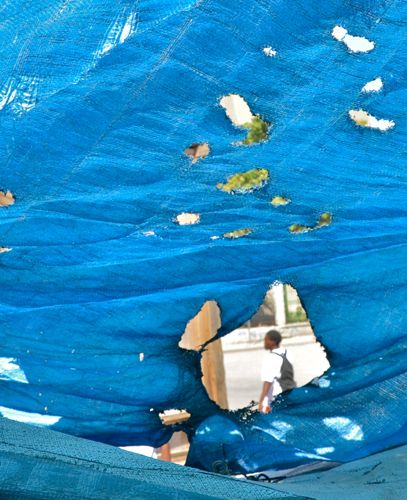
Can it be that only the thin veil of a tattered tarp separates us? Does it take burning tear gas canisters to pierce the veil and help us bridge the distance between "us" and "them?"
Next: A disturbing report from OCHA
